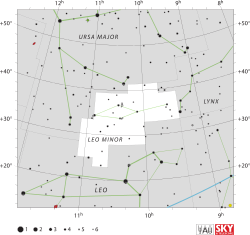|
| 41 Leonis Minoris |  | Observationsdata
Epok: J2000.0 |
|---|
| Stjärnbild | Lilla lejonet |
|---|
| Rektascension | 10t 43m 24,95671s[1] |
|---|
| Deklination | +23° 11′ 18,2499″[1] |
|---|
Skenbar magnitud ( ) ) | +5,08 (V)[2] |
|---|
| Stjärntyp |
|---|
| Spektraltyp | A3 Vn[3] |
|---|
| U–B | +0,06[4] |
|---|
| B–V | +0,04[4] |
|---|
| Astrometri |
|---|
Radialhastighet ( ) ) | +18,50[5] km/s |
|---|
| Egenrörelse (µ) | RA: -115,30[1] mas/år
Dek.: +7,62[1] mas/år |
|---|
Parallax ( ) ) | 14,23 ± 0,25[1] |
|---|
| Avstånd | 229 ± 4 lå (70 ± 1 pc) |
|---|
Absolut magnitud ( ) ) | +0,85[2] |
|---|
| Detaljer |
|---|
| Massa | 2,47[6] M☉ |
|---|
| Radie | 2,1[7] R☉ |
|---|
| Luminositet | 55[6] L☉ |
|---|
| Temperatur | 9 902[8] K |
|---|
| Metallicitet | -0,01 (Fe/H)[9] dex |
|---|
| Vinkelhastighet | 201[6] km/s |
|---|
| Ålder | 182[8] miljoner år |
|---|
| Andra beteckningar |
|---|
| 41 Lmi, AG+23 1111, BD+23 2253, FK5 405, GSC 01977-02632, HD 92825, HIC 52457, HIP 52457, HR 4192, IRAS 10406+2327, 2MASS J10432497+2311181, PLX 2506, PPM 100596, SAO 81490, TD1 15080, TYC 1977-2632-1, uvby98 100092825, WISE J104324.88+231118.3, Gaia DR2 723047852972321664 [10] |
41 Leonis Minoris, som är stjärnans Flamsteed-beteckning, är en ensam stjärna,[11] belägen i den södra delen av stjärnbilden Lilla lejonet. Den har en skenbar magnitud av ca 5,06[2] och är svagt synlig för blotta ögat där ljusföroreningar ej förekommer. Baserat på parallaxmätning inom Hipparcosuppdraget på ca 14,2[1] mas, beräknas den befinna sig på ett avstånd på ca 229 ljusår (ca 70 parsek) från solen. Den rör sig bort från solen med en heliocentrisk radialhastighet på ca 18,5 km/s.[5]
Egenskaper
41 Leonis Minoris är en blå till vit stjärna i huvudserien av spektralklass A3 Vn[3] där "n"-suffixet anger att stjärnan har "diffusa" (breddade) linjer i dess spektrum på grund av snabb rotation. Den har en massa som är ca 2,5[6] solmassor, en radie som är ca 2,1[7] solradier och utsänder från dess fotosfär ca 55[6] gånger mera energi än solen vid en effektiv temperatur av ca 9 900[8] K.
Referenser
- Den här artikeln är helt eller delvis baserad på material från engelskspråkiga Wikipedia, 41 Leonis Minoris, 27 april 2020.
Noter
- ^ [a b c d e f] Van Leeuwen, F. (2007). "Validation of the new Hipparcos reduction". Astronomy and Astrophysics. 474 (2): 653. arXiv:0708.1752. Bibcode:2007A&A...474..653V. doi:10.1051/0004-6361:20078357. Vizier catalog entry
- ^ [a b c] Anderson, E.; Francis, Ch. (2012). "XHIP: An extended hipparcos compilation". Astronomy Letters. 38 (5): 331. arXiv:1108.4971. Bibcode:2012AstL...38..331A. doi:10.1134/S1063773712050015. Vizier catalog entry
- ^ [a b] Hoffleit, D.; Warren, W. H. (1995). "VizieR Online Data Catalog: Bright Star Catalogue, 5th Revised Ed. (Hoffleit+, 1991)". VizieR On-line Data Catalog: V/50. Originally Published in: 1964BS....C......0H. 5050. Bibcode:1995yCat.5050....0H.
- ^ [a b] Mermilliod, J. C. (2006). "VizieR Online Data Catalog: Homogeneous Means in the UBV System (Mermilliod 1991)". VizieR On-line Data Catalog: II/168. Originally Published in: Institut d'Astronomie. 2168. Bibcode:2006yCat.2168....0M.Vizier catalog entry
- ^ [a b] Evans, D. S. (1967). "The Revision of the General Catalogue of Radial Velocities". Determination of Radial Velocities and their Applications. 30: 57. Bibcode:1967IAUS...30...57E.
- ^ [a b c d e] Zorec, J.; Royer, F. (2012). "Rotational velocities of A-type stars". Astronomy & Astrophysics. 537: A120. arXiv:1201.2052. Bibcode:2012A&A...537A.120Z. doi:10.1051/0004-6361/201117691. Vizier catalog entry
- ^ [a b] Allende Prieto, C.; Lambert, D. L. (1999). "Fundamental parameters of nearby stars from the comparison with evolutionary calculations: Masses, radii and effective temperatures". Astronomy and Astrophysics. 352: 555. arXiv:astro-ph/9911002. Bibcode:1999A&A...352..555A. Vizier catalog entry
- ^ [a b c] David, Trevor J.; Hillenbrand, Lynne A. (2015). "The Ages of Early-Type Stars: Strömgren Photometric Methods Calibrated, Validated, Tested, and Applied to Hosts and Prospective Hosts of Directly Imaged Exoplanets". The Astrophysical Journal. 804 (2): 146. arXiv:1501.03154. Bibcode:2015ApJ...804..146D. doi:10.1088/0004-637X/804/2/146. Vizier catalog entry
- ^ Gontcharov, G. A. (2012). "Dependence of kinematics on the age of stars in the solar neighborhood". Astronomy Letters. 38 (12): 771. arXiv:1606.08814. Bibcode:2012AstL...38..771G. doi:10.1134/S1063773712120031. Vizier catalog entry
- ^ "41 LMi". SIMBAD. Centre de données astronomiques de Strasbourg. Hämtad 2020-04-27.
- ^ Eggleton, P. P.; Tokovinin, A. A. (September 2008). "A catalogue of multiplicity among bright stellar systems". Monthly Notices of the Royal Astronomical Society. 389 (2): 869–879. arXiv:0806.2878. Bibcode:2008MNRAS.389..869E. doi:10.1111/j.1365-2966.2008.13596.x.
Externa länkar
|





